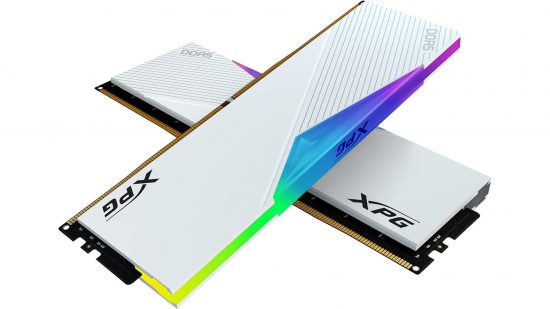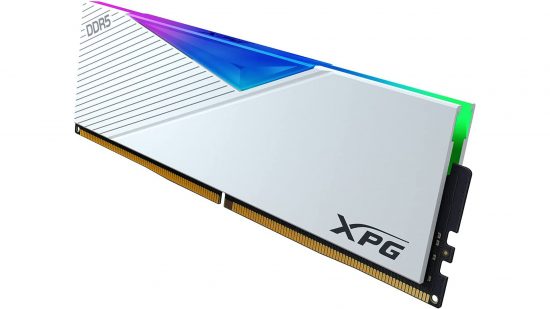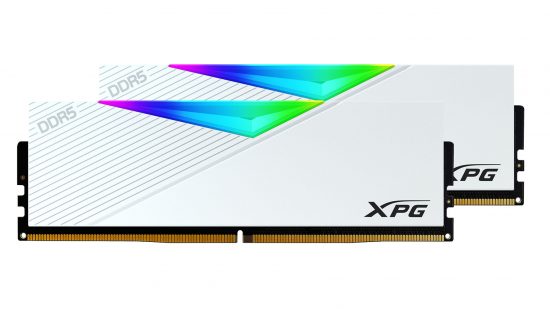Our Verdict
83%These attractive memory modules can be overclocked, but the lighting needs more punch.
ADATA has received a few great reviews from us in the past for both its memory and SSDs, and we’re hoping for more of the same mix of good value, decent aesthetics and solid features with its latest ADATA XPG Lancer RGB DDR5 memory too.
At Custom PC, we’ve been reviewing the latest memory since 2003, and we’ve tested and overclocked hundreds of kits, going right back to the original DDR era. We run both synthetic and application benchmarks to assess performance, and also see how far we can overclock each kit. In addition, we look at any RGB lighting features and assess how good it looks, as well as how well the control software works. For more information, check out our How we test page.
Under the hood, the ADATA XPG Lancer kit appears to be identical to the Kingston Fury Beast DDR5 RGB, with both kits using SK Hynix memory chips, which seem to be the top pick at the moment for 2nd-generation DDR5 modules. The 6000MHz frequency is also identical, as are the timings of 40-40-40-76, but the ADATA kit’s larger heatsinks kept the memory a couple of degrees cooler under load.
That said, the heatsinks aren’t actually that tall, sitting at a surprisingly low height of 43mm, which is significantly shallower than the Corsair Dominator Platinum RGB DDR5 modules. We also prefer the look of ADATA’s heatsinks here too.
ADATA seems to have fewer speed and capacity options available compared with Kingston, and it also offers several speeds of single-module kits. The potential AMD Socket AM5 sweet spot of 6000MHz is what ADATA sent us for the sample, with a dual-channel 32GB kit setting you back $250. That’s a little more than the Kingston Fury Beast DDR5 RGB, and that kit offers the same frequency and timings as well as more vivid lighting.

The XPG Lancer RGB’s lighting wasn’t unimpressive, though, as its light bar did a fantastic job of diffusing the RGB LEDs beneath it into a solid block of color, even when dishing out multiple colors at the same time. However, it was significantly dimmer than the lighting on the Kingston RGB DDR5 kits we’ve reviewed, so it isn’t ideal if you want your lighting to be punchy.
Unlike Kingston, ADATA offers no software to control the lighting either, so you’re either left with the default rainbow effect or you need to use your motherboard’s RGB software, courtesy of ASRock, Asus, Gigabyte or MSI.

ADATA XPG Lancer RGB overclocking
The ADATA memory did pip the Fury Beast DDR5 RGB to the post in overclocking, though, hitting 6400MHz as opposed to 6200MHz in our tests, matching the pricey Kingston Fury Renegade DDR5 RGB, albeit with looser latency timings.
Still, this tweak was enough for the ADATA to (just) get the highest scores in our RealBench image editing and video encoding benchmarks we’ve seen in a DDR5 memory test, but the results were so close, they’re within the margin of error.
ADATA XPG Lancer RGB pros and cons
Pros
- Pleasant, diffuse lighting
- Universal motherboard software compatibility
- Reached a 6400MHz overclock
Cons
- Lighting isn’t particularly bright
- Slightly more expensive than competition
- No in-house RGB lighting software
ADATA XPG Lancer RGB specs
The ADATA XPG Lancer RGB specs list is:
| Memory chip | SK Hynix |
| Effective frequency | 6000MHz |
| Timings | 40-40-40-76 |
| Voltage | 1.35V |
| Height (from base) | 43mm |
| XMP 3.0 support | Yes |
| RGB software compatibility | Asus Aura Sync, Gigabyte RGB Fusion 2.0, MSI Mystic Light Sync, ASRock Polychrome Sync |
ADATA XPG Lancer RGB price
Price: Expect to pay $250 (£242).
ADATA XPG Lancer RGB review conclusion
There’s a lot to like about the ADATA XPG Lancer RGB. It has attractive heatsinks, smooth, diffuse RGB lighting, reasonable overclocking headroom and good performance at stock speed and overclocked settings. There are a few negatives, though, such as a slightly higher price tag than the competition and a lack of RGB lighting software.
There’s also the issue of its RGB lighting not being that bright compared with the competition. To gauge the difference, we put a stick of Kingston Fury Beast memory in the slot next to an ADATA Lancer module, and the difference in lighting impact was like night and day.
If you want your RGB lighting to make a punchy impact, the ADATA kit isn’t for you. If you prefer a less aggressive light show, however, then it’s definitely worth considering.
You’ll be stuck with few capacity or frequency options with this range of DDR5 memory too, but 32GB and 6000MHz gives you a good balance between capacity, speed and price, especially if future CPUs do indeed make better use of high memory frequency than current chips, as rumored.
